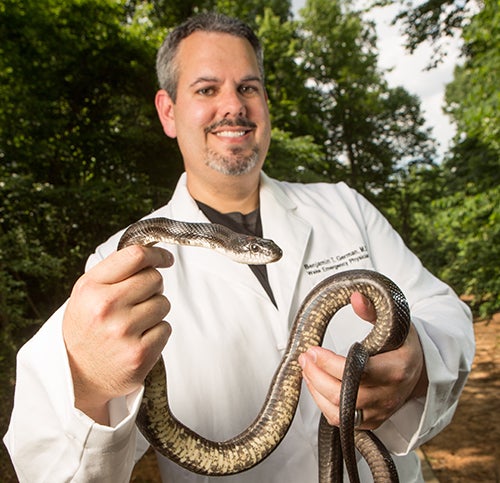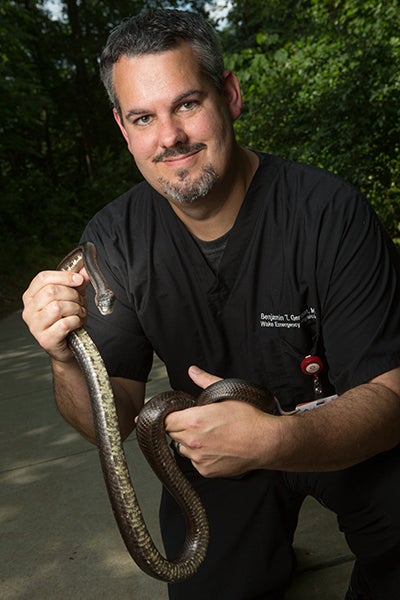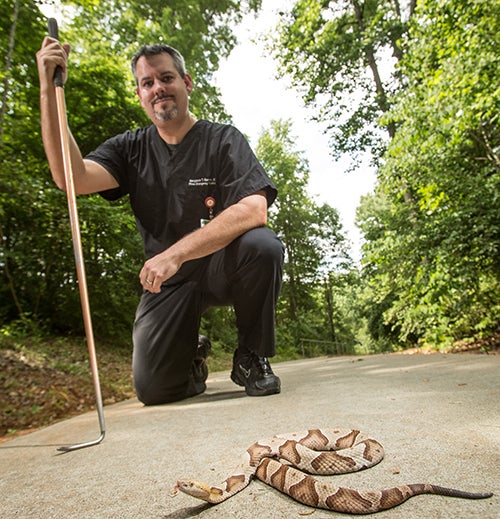Talk with the Venom Doc
July 12, 2024
By: WakeMed Health & Hospitals
Categories: Emergency, Urgent Care
Tags: copperhead snake, cottonmouth snake, snake bites, snake venom
Summertime means more of our slithery friends are coming out to play, so we caught up with Dr. Benjamin German, emergency medicine physician (also known as the Venom Doc). He’s a snake enthusiast who believes that families need to be educated about the facts, so they can reduce their fears and take safety precautions while enjoying the beautiful outdoors in North Carolina.
When did you take an interest in snakes?
 My interest in snakes goes back to when I was three years old and caught a snake in the yard. I had no idea what it was and when my parents saw what I had in my hands, there was great drama! Luckily for me, it was a non-venomous snake, but sometimes the story has a different ending. I think it’s important for everyone in our area to be educated about snakes and snake safety.
My interest in snakes goes back to when I was three years old and caught a snake in the yard. I had no idea what it was and when my parents saw what I had in my hands, there was great drama! Luckily for me, it was a non-venomous snake, but sometimes the story has a different ending. I think it’s important for everyone in our area to be educated about snakes and snake safety.
Which dangerous snakes are most common in our area?
In North Carolina, we have four types of venomous snakes.
- Copperhead snakes are the most common venomous snakes in Wake County and surrounding areas. You can find them anywhere in NC from the mountains to the coast. Bites are painful and cause swelling but are usually not as severe as rattlesnake or cottonmouth bites.
- Rattlesnake bites are a lot more serious than copperhead bites. These snakes are more common in the mountains or the eastern part of NC. You will most likely find them in undisturbed areas (big tracks of forest, game lands, etc.).
- Cottonmouth is a common name for the water moccasin. The name comes from the white lining in the snake’s mouth that they show when trying to scare predators away. There are many harmless water snakes that swim under water, but the water moccasin tends to stay close to the surface of the water. They are more common east and south of the Triangle.
- Coral snakes are red, black and yellow, and they are primarily found near the coast in the Wilmington area. These are very dangerous snakes, but there has never actually been a reported coral snake bite in NC.
How many snakebites are reported in the area?
WakeMed emergency departments see many snakebites every year, and the numbers keep increasing. The Triangle area has always had venomous snakes, but the human population has been rapidly growing for decades.
The increase in people living near snakes has driven up the number of bites. In the first half of 2024, NC saw 856 snake bites per the National Poison Data System — the second highest rate in the nation after Texas.
What are the biggest concerns with a snakebite?
Venomous snakebites are very painful due to the venom attacking and destroying tissue. The tissue damage leads to swelling that can involve an entire limb and take weeks to resolve. Some patients have swelling and limb dysfunction that lasts even longer and impairs their functioning. Bites into a finger or toe can cause severe damage to the digit and can occasionally lead to digit loss. Death is extremely rare and almost never occurs with copperhead bites. Out of over 5000 venomous snakebites, only two to five people die every year in the US. Prior to antivenom and modern medical care, many more people died.

Are the concerns different for children?
This time of year is when snakes are starting to become active." explains Dr. Benjamin German. "If you’re outside, and you and your children feel comfortable — it feels like a nice day — then the snakes feel the same way.
Monitor your children. They are more susceptible to a possible bite if playing in dense brush or heavily wooded areas.
Bites can be more severe in children because they are smaller. This is particularly true with bites from large rattlesnakes, which are thankfully very rare in NC.
What should you do if a snake bites someone?
Always seek prompt medical attention if you think a venomous bite may have occurred. Call 911 if the victim is having breathing problems or other serious issues. It’s okay to clean the area with soap and water. Keep the bite victim calm and still (minimize movement of their extremities). DON’T make cuts, apply wraps, tourniquets, suction, ice or do anything else to the bite. Reassure the victim that it’s treatable and almost never fatal.

* In the U.S., fewer than five people die each year from snakebites. Typically they are cases where people didn’t seek quick treatment or had very unusual circumstances.
When and where do snakebites happen the most?
Most snakebites happen close to home in yards, parks and along trails. It’s common for people to let their guard down in more familiar areas. The warmer months are when both people and snakes start to move around more. Snakes like wooded areas, overgrown lots, wood piles, overgrown lots and creek banks (not necessarily in the water). You will also find them around bushes, fallen logs, leaf litter, mulch piles and rock walls with crevices.
Are there common bite situations that people should know about?
 Snakebites are nearly 100% avoidable. Nearly all bites occur to the feet and hands. Snakes tend to be nocturnal, so many bites happen at dusk when people are taking out the trash, walking a pet, or cleaning up the yard late in the day. If you reach into an area and startle them or step on them, snakes bite in self-defense. Good footwear goes a long way in preventing bites.
Snakebites are nearly 100% avoidable. Nearly all bites occur to the feet and hands. Snakes tend to be nocturnal, so many bites happen at dusk when people are taking out the trash, walking a pet, or cleaning up the yard late in the day. If you reach into an area and startle them or step on them, snakes bite in self-defense. Good footwear goes a long way in preventing bites.
What should families know to minimize a bite risk?
- Look where you are walking and reaching.
- Teach children not to pick up or poke snakes (not even with a stick).
- Instruct kids to walk away and tell an adult if they see a snake.
- Don’t teach kids to kill a snake. They are more likely to get a bite.
- Snakes can actually still bite you after you think they are dead.
* Even when a snake’s head is severed from its body, it can still bite for an hour after or more. If a snake poses a danger and is killed, it should be buried out of reach.
How can families keep snakes away from their homes?
The best thing to do is make your yard unattractive to them. They don’t want to be out in the open.
Don’t give them a home or place to hide. Keep shrubs trimmed up and off the ground. Bird feeders can attract them because the food underneath attracts mice and squirrels, which snakes prey on, so keep feeders further away from the house.
Are there any myths you want to debunk?
Snakes aren’t likely to go out of their way to bite you, and they don’t chase you. Even the ones that can move quickly aren’t going to outpace a person who purposefully walks away.
Infection after a snakebite is very rare and antibiotics aren’t usually needed. Don’t put a lot of faith in snake repellents; they aren’t really necessary.
What do you tell people who are afraid of snakes?
Keep your cool. People can get over their fears and learn not to overreact by learning a little bit about snakes. Take the family to a museum and watch snakes in enclosed cases. You’ll see they aren’t that active. They tend to just sit in the same spot and wait for prey. Remember, people aren’t really their prey.
Why do snakes bite?
If they bite someone, it’s a last resort for them. They don’t gain from it. Occasionally, if you step in front of one, they might mistake you for a food source. Otherwise, they bite when they are startled, antagonized or scared.
What’s the typical treatment for a bite?
If the snake is venomous or you are unsure, seek medical attention. The only effective treatment for venomous snakebites is antivenom. Antivenom consists of antibodies that bind and neutralize the venom toxins. In the ER, we check vital signs, assess and monitor the bite for worsening, treat pain and then determine if antivenom is needed. Not all bites need antivenom, but any venomous bite should be monitored for a minimum 6-8 hours. Often, a bite worsens rapidly and the decision to give antivenom is made quickly. Sometimes, bites don’t start to worsen for hours, so monitoring and reassessment is key.
If the bite is from a non-venomous snake (harmless), we usually make sure you’re up to date on your tetanus shot, perform wound care, and then you go home.
*Any snakebite with severe or worsening pain is probably venomous. Bites from non-venomous snakes cause only minimal local pain that improves quickly.
Quick Tips for a Snake Bite
- Act quickly: Call 911 if venomous or the type is unknown. A mobile phone is your best tool in the first aid kit.
- If in the wilderness, get to help as fast as possible. Find a forest ranger.
- If you can’t reach anyone by phone, send someone for help.
- As a last resort, carefully carry the person to someone with a phone.
Where to Seek Care
You are welcome to visit one of our WakeMed emergency care facilities if suffer a snake bite. We are ready and able to provide you the comprehensive care you need right away.
"Any patient with worsening pain, swelling or any other concerning symptoms should be evaluated in person by a medical provider," says Dr. Benjamin German.